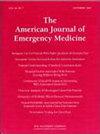Emergency medicine updates: Cardiopulmonary resuscitation
IF 2.7
3区 医学
Q1 EMERGENCY MEDICINE
引用次数: 0
Abstract
Introduction
Cardiac arrest is the loss of functional cardiac activity; emergency clinicians are integral in the management of this condition.
Objective
This paper evaluates key evidence-based updates concerning cardiopulmonary resuscitation (CPR).
Discussion
Cardiac arrest includes shockable rhythms (i.e., pulseless ventricular tachycardia and ventricular fibrillation) and non-shockable rhythms (i.e., asystole and pulseless electrical activity). The goal of cardiac arrest management is to achieve survival with a good neurologic outcome, in part by restoring systemic perfusion and obtaining return of spontaneous circulation (ROSC), while seeking to diagnose and treat the underlying etiology of the arrest. CPR includes high-quality chest compressions to optimize coronary and cerebral perfusion pressure. Chest compressions should be centered over the mid-sternum, with the compressor's body weight over the middle of the chest. A compression depth of 5–6 cm is recommended at a rate of 100–120 compressions per minute, while allowing the chest to fully recoil between each compression. Clinicians should seek to minimize any interruptions in compressions. When performed by bystanders, compression-only CPR may be associated with improved survival to hospital discharge when compared to conventional CPR with ventilations. However, in trained personnel, there is likely no difference with compression-only versus conventional CPR. Mechanical approaches for CPR are not associated with improved patient outcomes, including ROSC or survival with good neurologic function, but mechanical compression devices may be beneficial in select circumstances (e.g., few rescuers available, prolonged arrest/transport). Monitoring of chest compressions is not associated with improved ROSC, survival, or neurologic outcomes, but it can improve guideline adherence. Types of monitoring include real-time feedback, a CPR coach, end tidal CO2, arterial line monitoring, regional cerebral tissue oxygenation, and point-of-care ultrasound.
Conclusions
An understanding of CPR literature updates can improve the ED care of patients in cardiac arrest.
急诊医学更新:心肺复苏术
心脏骤停是指心脏功能活动的丧失;急诊临床医生在这种情况的管理是不可或缺的。目的评价心肺复苏(CPR)的关键循证最新进展。心脏骤停包括震荡性节律(即无脉性室性心动过速和心室颤动)和非震荡性节律(即无脉性和无脉性电活动)。心脏骤停管理的目标是通过恢复全身灌注和恢复自然循环(ROSC),同时寻求诊断和治疗心脏骤停的潜在病因,从而获得良好的神经系统预后。心肺复苏术包括高质量的胸部按压,以优化冠状动脉和脑灌注压。胸部按压应以胸骨中部为中心,按压者的身体重量在胸部中部。建议按压深度5-6厘米,按压速度为每分钟100-120次,同时让胸部在每次按压之间充分后坐力。临床医生应尽量减少任何中断的压迫。当由旁观者执行时,与常规心肺复苏术加通气相比,单纯按压心肺复苏术可提高患者出院时的存活率。然而,在训练有素的人员中,单纯按压与常规CPR可能没有区别。机械CPR入路与改善患者预后(包括ROSC或神经功能良好的生存)无关,但机械压迫装置可能在某些情况下是有益的(例如,可用的救援人员很少,长时间的骤停/转运)。胸外按压监测与ROSC、生存或神经预后的改善无关,但它可以提高指南的依从性。监测类型包括实时反馈、心肺复苏术指导、末潮CO2、动脉线监测、局部脑组织氧合和即时超声。结论了解心肺复苏术的最新文献可以提高心脏骤停患者的急诊护理水平。
本文章由计算机程序翻译,如有差异,请以英文原文为准。
求助全文
约1分钟内获得全文
求助全文
来源期刊
CiteScore
6.00
自引率
5.60%
发文量
730
审稿时长
42 days
期刊介绍:
A distinctive blend of practicality and scholarliness makes the American Journal of Emergency Medicine a key source for information on emergency medical care. Covering all activities concerned with emergency medicine, it is the journal to turn to for information to help increase the ability to understand, recognize and treat emergency conditions. Issues contain clinical articles, case reports, review articles, editorials, international notes, book reviews and more.

 求助内容:
求助内容: 应助结果提醒方式:
应助结果提醒方式:


